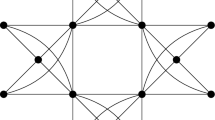Abstract
For any positive integer n, we use [n] for the set \(\{1,\ldots ,n\}\). For any integers \(a_1,\ldots ,a_n \ge 2\) and \(k\ge 1\), the generalized Hamming graph \(\mathrm {H}_{a_1,\ldots ,a_n}^{k}\) is the graph with vertex set \([a_1]\times \cdots \times [a_n]\) in which two different vertices are adjacent if and only if their Hamming distance is at most k. We determine the phylogeny number of \(\mathrm {H}_{a_1,\ldots ,a_n}^{1}\) and that of \( \mathrm {H}_{m,m,m}^{2}\); we also calculate the phylogeny number of \(\mathrm {H}_{a_1,\ldots ,a_n}^{n-1}\) when \(a_1=\cdots =a_n \) is sufficiently large. In the course of establishing a lower bound estimate of phylogeny numbers, we make use of our former result on the rank of the rainbow inclusion matrices; our upper bound estimate comes from a concrete construction of a minimum size percolating set in a special bootstrap process.

Similar content being viewed by others
References
Cohen, J.E.: Interval Graphs and Food Webs: A finding and a problem. Document 17696-PR, RAND Corporation (1968). https://lab.rockefeller.edu/cohenje/assets/file/014.1CohenIntervalGraphsFoodWebsRAND1968.pdf
Roberts, F.S.: Food webs, competition graphs, and the boxicity of ecological phase space. In: Alavi, Y., Lick, D.R. (eds.) Theory and Applications of Graphs. Lecture Notes in Mathematics, vol. 642, pp. 477–490. Springer-Verlag, Berlin (1978). https://doi.org/10.1007/BFb0070404
Roberts, F.S., Sheng, L.: Phylogeny numbers. Discrete Appl. Math. 87(1–3), 213–228 (1998). https://doi.org/10.1016/S0166-218X(98)00058-4
Lauritzen, S.L., Spiegelhalter, D.J.: Local computations with probabilities on graphical structures and their application to expert systems. J. Roy. Statist. Soc. Ser. B 50(2), 157–224 (1988). https://doi.org/10.1111/j.2517-6161.1988.tb01721.x
Li, Y., Allison, L., Korb, K.B.: The difficulty of being moral. Theoret. Comput. Sci. 885, 77–90 (2021). https://doi.org/10.1016/j.tcs.2021.06.024
Opsut, R.J.: On the computation of the competition number of a graph. SIAM J. Algebraic Discrete Methods 3(4), 420–428 (1982). https://doi.org/10.1137/0603043
Bespalov, E.A., Krotov, D.S., Matiushev, A.A., Taranenko, A.A., Vorob’ev, K.V.: Perfect 2-colorings of Hamming graphs. J. Combin. Des. 29(6), 367–396 (2021). https://doi.org/10.1002/jcd.21771
Huang, J.: Norton algebras of the Hamming graphs via linear characters. Electron. J. Combin. 28(2), 1–36 (2021). https://doi.org/10.37236/10251
Kivva, B.: A characterization of Johnson and Hamming graphs and proof of Babai’s conjecture. J. Combin. Theory Ser. B 151, 339–374 (2021). https://doi.org/10.1016/j.jctb.2021.07.003
Valyuzhenich, A.: Eigenfunctions and minimum \(1\)-perfect bitrades in the Hamming graph. Discrete Math. 344(3), 1–9 (2021). https://doi.org/10.1016/j.disc.2020.112228
Gologranc, T.: Tree-like partial Hamming graphs. Discuss. Math. Graph Theory 34(1), 137–150 (2014). https://doi.org/10.7151/dmgt.1723
Sander, T.: Eigenspaces of Hamming graphs and unitary Cayley graphs. Ars Math. Contemp. 3(1), 13–19 (2010). https://doi.org/10.26493/1855-3974.100.7f8
Park, B., Sano, Y.: The competition numbers of Hamming graphs with diameter at most three. J. Korean Math. Soc. 48(4), 691–702 (2011). https://doi.org/10.4134/JKMS.2011.48.4.691
Park, B., Sano, Y.: The competition numbers of ternary Hamming graphs. Appl. Math. Lett. 24(9), 1608–1613 (2011). https://doi.org/10.1016/j.aml.2011.04.012
Wu, Y., Xiong, Y., Zaw, S.: Competition numbers and phylogeny numbers: uniform complete multipartite graphs. Graphs Combin. 35(3), 653–667 (2019). https://doi.org/10.1007/s00373-019-02023-4
Xiong, Y., Zaw, S., Zhu, Y.: Competition numbers and phylogeny numbers of connected graphs and hypergraphs. Algebra Colloq. 27(1), 79–86 (2020). https://doi.org/10.1142/S1005386720000073
Eoh, S., Kim, S.-R., Lee, H.: The phylogeny number in the aspect of triangles and diamonds of a graph (2019) arXiv:1904.07420
Cable, C., Jones, K.F., Lundgren, J.R., Seager, S.: Niche graphs. Discrete Appl. Math. 23(3), 231–241 (1989). https://doi.org/10.1016/0166-218X(89)90015-2
Eoh, S., Choi, J., Kim, S.-R., Oh, M.: The niche graphs of bipartite tournaments. Discrete Appl. Math. 282, 86–95 (2020). https://doi.org/10.1016/j.dam.2019.11.001
Scott, D.D.: The competition-common enemy graph of a digraph. Discrete Appl. Math. 17(3), 269–280 (1987). https://doi.org/10.1016/0166-218X(87)90030-8
Wu, Y., Lu, J.: Dimension-2 poset competition numbers and dimension-2 poset double competition numbers. Discrete Appl. Math. 158(6), 706–717 (2010). https://doi.org/10.1016/j.dam.2009.12.001
Belmont, E.: A complete characterization of paths that are \(m\)-step competition graphs. Discrete Appl. Math. 159(14), 1381–1390 (2011). https://doi.org/10.1016/j.dam.2011.04.026
Cho, H.H., Kim, S.-R., Nam, Y.: The \(m\)-step competition graph of a digraph. Discrete Appl. Math. 105(1–3), 115–127 (2000). https://doi.org/10.1016/S0166-218X(00)00214-6
Balogh, J., Bollobás, B., Morris, R., Riordan, O.: Linear algebra and bootstrap percolation. J. Combin. Theory Ser. A 119(6), 1328–1335 (2012). https://doi.org/10.1016/j.jcta.2012.03.005
Qian, C., Wu, Y., Xiong, Y.: Collapsible rainbow simplicial complex: Face vector and tree structure (2022). https://math.sjtu.edu.cn/faculty/ykwu/data/Paper/Rainbow_Simplicial_Complex.pdf
Qian, C., Wu, Y., Xiong, Y.: Inclusion matrices for rainbow subsets (2022). https://math.sjtu.edu.cn/faculty/ykwu/data/Paper/220621.pdf
Wu, Y., Xiong, Y.: Sparse \((0,1)\) array and tree-like partition system (2020). https://math.sjtu.edu.cn/faculty/ykwu/data/Paper/sparsity1001.pdf
Frankl, P., Pach, J.: On well-connected sets of strings. Electron. J. Combin. 29(4), 1–6 (2022). https://doi.org/10.37236/10291
Author information
Authors and Affiliations
Corresponding author
Additional information
Communicated by Xueliang Li.
Publisher's Note
Springer Nature remains neutral with regard to jurisdictional claims in published maps and institutional affiliations.
Supported by NSFC 11971305.
Rights and permissions
About this article
Cite this article
Qian, C., Wu, Y. & Xiong, Y. Phylogeny Numbers of Generalized Hamming Graphs. Bull. Malays. Math. Sci. Soc. 45, 2733–2744 (2022). https://doi.org/10.1007/s40840-022-01338-5
Received:
Revised:
Accepted:
Published:
Issue Date:
DOI: https://doi.org/10.1007/s40840-022-01338-5




